
Everything you need to know about squatting
Introduction :
The squat is a fundamental bodybuilding exercise that focuses primarily on the leg muscles while also engaging many other muscle groups.
In this article, we will explore in detail the basics of the squat, its benefits, possible variations and give you tips for correct and safe execution.
What is squatting?
The squat is a multi-joint strength training exercise that involves simultaneously bending the hips and knees while keeping the back straight, lowering the body to the floor and then returning to a standing position. It primarily works the quadriceps, hamstrings, glutes, and lower back muscles, but also engages the core's stabilizing muscles, strengthening overall stability and balance.
The benefits of squatting:
- Muscle strengthening:
When you perform a squat, the leg muscles, such as the quadriceps, hamstrings, and adductors, are intensely engaged. This helps develop the strength and power of these muscles, which translates to better performance in various physical activities, such as running, jumping, and sports that require explosive movements.
The glutes are also heavily used during squats. These muscles play a crucial role in hip stability and power. Proper glute development not only helps improve athletic performance, but can also have aesthetic benefits by sculpting firm, toned buttocks.
Additionally, squatting engages your core muscles, including your abdominals, lower back, and obliques. These muscles play an important role in maintaining body and back stability during exercise, which helps prevent injuries and promotes good posture.
- Improved mobility:
Finally, your knees will also benefit from greater flexibility, which can help prevent injuries and maintain good posture during exercise. Improved mobility in your hips, ankles, and knees also has positive implications for other exercises and daily activities. You may find that you can squat more easily to lift objects, bend more smoothly, and move with greater freedom.
Additionally, better posture and greater overall range of motion will allow you to perform other exercises more efficiently and safely, minimizing the risk of injury.
- Increased bone density:
Squat variations:
- Classic Squat : The classic squat, also known as the barbell squat, involves placing a barbell on your shoulders, in either the high or low position, and bending your knees to lower into a squat position. It focuses on the quadriceps, glutes, and hamstrings.
- Goblet Squat : The goblet squat is a variation where you hold a single dumbbell or kettlebell in front of your chest, in an upright position, while performing the squat. This helps maintain good posture and strengthens the quads and glutes.
- Sumo Squat: The sumo squat is performed with the feet wider than shoulder-width apart, with the toes turned slightly outward. It primarily targets the adductor muscles of the thighs and glutes.
- Bulgarian Split Squat: The Bulgarian split squat, also known as the Bulgarian split lunge, is a variation where you place one foot on a raised platform, such as a bench, while the other leg performs the squatting movement. This focuses on the quads, glutes, and hamstrings, while improving balance and stability.
- Pistol squat : The pistol squat is an advanced variation where you perform a single-leg squat while keeping the other leg extended in front of you. This strengthens the quads, hamstrings, glutes, and improves ankle stability.
- Jump Squat: The jump squat is a variation that adds a cardio element to the exercise. After bending your knees in a squat position, you perform an explosive jump into the air, then return to a squat position upon landing. This increases cardiovascular effort while strengthening your legs.

Tips for good execution:
- Body position: Keep your back straight, shoulders back, and gaze forward. Your chin should be slightly raised, avoiding looking directly at the floor.
- Hip and knee bends: Lower yourself by bending your hips and knees simultaneously, keeping your heels on the floor. Your knees should be aligned with your toes.
- Range of motion: Lower yourself until your thighs are parallel to the floor or slightly below. If you have mobility issues, you can start with a partial range of motion and work your way up to a full range of motion.
- Heel Push: Push through your heels to return to standing, contracting your leg and glute muscles.
- Movement Control: Control the descent and ascent of the squat, avoiding jerks or rapid movements. Slow, controlled execution maximizes the effectiveness of the exercise and reduces the risk of injury.
The squat is a versatile and effective exercise for strengthening the legs, glutes, and core muscles. By understanding the basics of the squat, exploring its variations, and performing it correctly, you can fully enjoy its many benefits.

